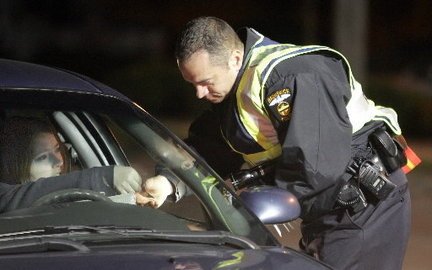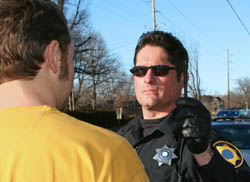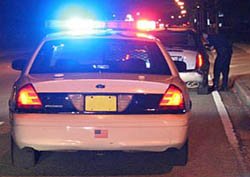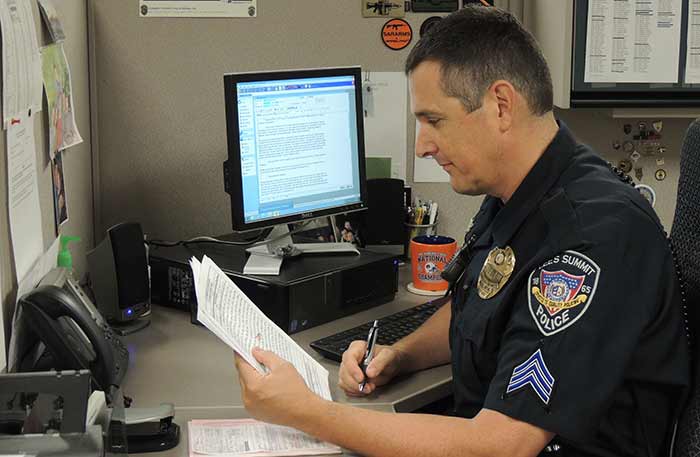
Recently, I was talking to some officers about the finer skills of detecting impaired drivers, and I got a lot of glassy eyed looks in return. The one area that turns more cops away from DUI enforcement (other than the time and paperwork required) is the Standardized Field Sobriety Tests (SFST). Most cops avoid getting into a situation that may make them look flustered, more than a preacher avoiding a porno shop. Hopefully I can dispel some of those distastes in this series of police training articles and get more cops stopping the human torpedoes on the roadways.
EDITOR’S NOTE: This is part one of a series on DUI training and detection. The author is a NHTSA certified SFST instructor and DRE instructor. Additionally, he spent several years in a DUI task force. Other articles in this series cover Walk and Turn, One Leg Stand, Personal Contact, Horizontal Gaze Nystagmus and specific safety concerns when conducting DUI investigations. Also, be sure to check out our information on detecting drugged drivers.
Author’s Training and Experience
To provide our readers a basis to gauge the information included in the DUI series, I will provide some background on my training and experience. I was an SFST instructor for nearly 12 years. In addition, I was a DRE (Drug Recognition Expert) for over 10 years, and DRE instructor for 9 years. For nearly 2.5 years I was assigned to our Traffic Unit, specifically as a DWI enforcement officer. Finally, I worked 2 years in undercover investigations for a HIDTA drug task force where the emphasis was on methamphetamine manufacturing and distribution, but also covered serious investigations in cocaine and heroin.

I can absolutely attest that if you want to win the DUI conviction, AND stay out of court as much as possible, than you had better become masters of documenting everything you can for the DUI report. I have heard too many officers believe the less written in the report the better. It is true that anything you write “can and will be used against you in a court of law”, but in DUI investigations the less you write will cause you much more grief. Including intricate details provides plenty of back-up in case a few observations are written off by a judge or jury as “normal”, and the better the image of impairment the easier it is to make your case.
Defense attorney usually prey on the weak, and avoid the humiliation of the strong report. I have been grilled by some very good attorneys, but once they realized I knew what I was talking about and could articulate facts and observations to a logical conclusion (your client was a disaster), my name made the circuit and I rarely had to come and testify in court again on DUI matters. And for a DUI enforcement guy who works the dog hours, not being called into early morning or afternoon court was a nice reprieve.
When I taught officers the SFST course I emphasized something that most had never even considered – THE SUSPECT WILL REFUSE ALL OF YOUR TESTS AND MAY NOT EVEN TALK TO YOU. We aren’t too surprised when they refuse the BAC instrument test, but many an officer has had the deer-in-the-headlight look when the suspect refuses ALL of the SFST tests you want to administer. Suddenly the confidence in arrest goes by the wayside.
Most officers expect to make their impairment case from the SFST (which they administer poorly and may lose in court). Police were making good DUI arrests in the 1920’s when we didn’t have the SFST as we know them now or videos, so we can surely do it now. In my State to be convicted of DUI the driver simply has to “operate a motor vehicle, anywhere in the state, in an intoxicated or drugged condition”. Doesn’t say anything about failing the SFST or having a .08% BAC or above (although statutorily the .08% and above means the driver is intoxicated). So showing that a person couldn’t control their vehicle, and had signs of intoxication, could be all you need to secure conviction.
Get ready for the refusal. I’m not advocating tossing the SFST at all. On the contrary, the SFST are remarkable tools that can garner enormous credibility to your arrest decision when administered properly. Take full advantage of every stage of the enforcement, but be ready when the offender throws a wrench in your plans.
PHASE I – VEHICLE IN MOTION
In this part of DUI enforcement officers are the most comfortable. This is basically observing a vehicle conducting traffic violations and making the stop. Most officers have done enough traffic stops they feel comfortable with the processes needed to complete this part. Moving violations are the best for DUI stops, because they can be directly correlated to the driver’s inability to operate a motor vehicle safely.
According to the National Highway Traffic Safety Administration (NHTSA), the clues for potential impaired driving can be narrowed to four categories of violations:
- Problems in maintaining proper lane position
- Speed and braking problems
- Vigilance problems
- Judgment problems.
NHTSA is the same organization that conducted a broad and scientific study to develop the (3) standardized and validated field sobriety tests (Horizontal Gaze Nystagmus, Walk-and-Turn, and One-Leg-Stand). That study involved hundreds of officers, thousands of stops and field testing, and input from doctors, psychiatrists, and lab technicians.
When compiling the traffic violations guide to best identify impaired drivers, NHTSA once again performed a massive study using hundreds of officers and more than 12,000 enforcement stops. Researchers interviewed officers from across the United States and developed a list of more than 100 driving cues that have been found to predict blood alcohol concentrations (BAC) of 0.08% or greater. The list was then reduced to 24 cues during 3 extensive field studies.
Now I’m the first to admit that large tables of information are often forgotten and the information lost over time. I would never teach officers to memorize these driving violations, or to remember the percentages of the combined violations. Instead, I would recommend officers occasionally review the chart to keep violations fresh in their memory. Many are common sense violations, like failing to maintain a single lane of traffic or violating a red traffic signal or stop sign. However, there are many others that might be forgotten if the officer doesn’t occasionally look over the list to refresh their memory.
In general, weaving is one of the strongest clues of impaired driving. When weaving is combined with other clues the chances of the driver being impaired rise significantly. As with almost everything in police enforcement actions, the decision to stop, test, or arrest, should only be made when the totality of the circumstances would lead a reasonable officer to believe their is probable cause to do so.
DWI Detection Guide
From the actual NHTSA guideline officers can learn important correlations with the violations they are observing. For instance, weaving plus any other cue is likely to indicate an impaired driver 65% of the time. Any two of the other cues, when combined together, is likely to locate an impaired driver at least 50% of the time.
Problems Maintaining Proper Lane Position: between 5 0% and 75%.
- Weaving
- Weaving across lane lines
- Straddling a lane line
- Swerving
- Turning with a wide radius
- Drifting
- Almost striking a vehicle or other object.
Speed and Braking Problems: between 45% to 70%.
- Stopping problems (too far, too short, or too jerky)
- Accelerating or decelerating for no apparent reason
- Varying speed (noticeably going faster than slower)
- Slow speed (10+ mph under limit).
Vigilance Problems: 55% to 65%
- Driving in opposing lanes or wrong way on one-way
- Slow response to traffic signals
- Slow or failure to respond to officer’s signals
- Stopping in lane for no apparent reason
- Driving without headlights at night
- Failure to signal or signal inconsistent with action.
Judgment Problems: 35% to 90%.
- Following too closely
- Improper or unsafe lane change
- Illegal or improper turn (too fast, jerky, sharp, etc.)
- Driving on other than the designated roadway
- Stopping inappropriately in response to officer
- Inappropriate or unusual behavior (throwing objects, arguing, etc.)
- Appearing to be impaired.
My Department has a specific prohibition on pursuing violators the wrong way on divided highways. The reasoning for this prohibition is it is too dangerous for the officers. Not to mention, if an officer going the wrong way on a divided highway becomes involved in a head-on collision there is a tremendous amount of liability attached to that collision- emergency lights and siren not withstanding.
I’m not faulting the Georgia officers in the video who were doing their best to stop this impaired driver, but could officers have raced ahead of the driver, entered the highway in the right direction to slow and block traffic, and then used Stop Sticks to bring the driver to a stop? What are your department’s policies on wrong-way driver pursuits?
Documenting Observed Violations
However, any violation that gives you a legal contact is acceptable. For example, one time I was heading back into traffic patrol when I rolled up on a truck with expired license plates stopped at a red traffic signal. When the light turned green the truck began to go, I positioned my patrol car behind the truck, and initiated a stop within 200 yards of where I first saw the truck. Upon contacting the driver, I was immediately confronted by the strong odor of an intoxicating beverage on his breath, despite the half can of snuff tobacco he had put in his lip to try to mask the odor.
Good stop, good observations, poor performance on SFST, resulted in arrest and conviction of DWI. Obviously moving violations are better, but any lawful contact with a driver will suffice.
The weakness of most officers is the lack of detail about those violations in their report. Simply naming the violation may suffice for obvious cases of intoxication, but when the suspect gets a well-trained and experience attorney you can bet they will attack the reason for the stop the hardest. Why? If they can create doubt in the stop, everything after the stop can become the “fruit of the poisonous tree”.

For example, if an officer simply writes “…the vehicle crossed the center line of the highway” in his/her report, there is a lot of room for interpretation of how bad that violation may have been.
A better way of documenting the same violation would be, “the vehicle was weaving back and forth before crossing approximately one half of the car’s width over the center line, before an abrupt swerve back into its lane.”
Painting the second picture makes it much more clear to the judge, prosecutor, and the 12 unlucky citizens that made jury duty that this driver had no business on the road. When those moving violations are more subtle, detail is the difference between success and failure in the court.
This is a good time to learn and become consistent with definitions used by officers to describe vehicular motion. These are the definitions that I used to describe the most commonly observed actions of impaired drivers, and I used them consistently (standardized). To some officers these definitions may not fit, but as long as you use these terms consistently with how you define them you should be fine in court.
Weaving – To me this is like sewing with thread and needle. There is a nice steady movement from one side of the lane/road to the other. Nothing too drastic, and the movement is in both directions. Weaving can be documented even when the vehicle does not leave the lane of travel.
Most State’s have a law requiring a driver to maintain their lane of travel unless lawfully turning. Just because the driver doesn’t leave the lane lines, doesn’t mean documenting their erratic movements is not a good idea. Also, think about smaller cars or motorcycles. They very well may not leave the lane, but if they’re all over the lane, this is a good observation that they are struggling to simply drive.
Drifting – I like to think of a snow drift or a sand drift (depending on your part of the country). The wind blows the drift in a fairly consistent pattern and direction. So the vehicle is going out of the lane/road in one direction, but the motion is steady and not abrupt or drastic. The vehicle may return to the lane of travel, but the violation is always to the same side, unlike weaving where the vehicle is leaving the lane to both sides.
Swerving – This is the sudden and jerky movement of the vehicle in the driver’s attempt to maintain the lane of travel.
Don’t stop observing and documenting after observing the initial violations. Note what the driver did when you turned the lights on, when they finally stopped, where they finally stopped, etc. The guy that stops in the lane of traffic, or drives over the curb could be a CLUE. The guy that keeps driving at low speeds like you’re not there could be a CLUE! Lots of good stuff to document to add to your case.

Final Thoughts
The Vehicle in Motion (driving offenses) is what leads most officers to come into contact with impaired drivers. The clues observed during this phase can be very enlightening and create a vivid picture of the suspect’s impairment. Officers are encouraged to focus on more than the obvious violation, but to include manners of driving and the more subtle clues.
How bad was the violation, what were the driving tendencies, how fast or slow did the driver respond to the emergency lights to pull over, did they pull over in an appropriate place and manner. All of these clues explain the stop much more clearly than “Saw drunk, arrested same.”
So here’s what is important to document during VEHICLE IN MOTION:
- Detailed descriptions of violations or other impaired actions.
- Describe the roadway, lighting conditions, and weather conditions.
- Include aggravating circumstances of the driving location. There is nothing more distasteful to a judge or jury then a description of an impaired driver carelessly driving into a downtown area full of pedestrians, while its raining.
- How did the driver respond to the signal to stop.
- Where and in what manner did the suspect stop their vehicle.
The most critical component of this phase of DWI detection is recognizing the driving behaviors that are likely to indicate impairment. Sure, many motorists speed, but when taken into context of time of day or proximity to a bar district, the simple violations may be much more indicative of an impaired driver than otherwise. Once the driving behaviors are observed the job of the officer is not done, but just beginning. Documenting those observations thoroughly in your report is paramount. The old saying applies here – If it ain’t in the report, it didn’t happen!
Leave a Reply